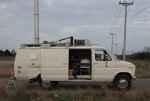|
EL PASO, TX 8 Apr 2012 --Doug AE5HE The "mesh movement" in El Paso started a couple of years ago when Lew Maxwell kb5hpt, Warren Beadle ke5apx and myself did a program on digital modes for ham at a couple of local ham clubs. We knew about the concepts of hsmm but not much more. About 4 of us were really interested in the technology but we didn't know where to start. Then we were able to attend a webinar put on by the North Texas group. For me personally that webinar was like taking the blinders off. Virtually all of my questions were answered including where to get the routers, firmware, antennas, etc. . . My credit card took a hit that month!
Now we were off and running. Within a couple of months we had about 8 nodes to work with and were experimenting with the basics in a local ham radio clubhouse. As our understanding of the mesh nodes grew, we moved out to local parks to get some distance between the nodes. We started by sharing video, web pages and even setup a D-Rats Reflector across the mesh.
After about a year of casual experimenting we were confident we could use the mesh system to provide support for a public event. In February of 2011 the Sun City Amateur Radio Club was providing radio communications support for the Susan G. Komen Race for the Cure. Lew was net control for that event and he asked the organizers if they would be interested in having video of the course for the 2012 event, "you can do that? absolutely!" was their response. Now our group had something to focus on.
We scheduled monthly meetings in the parks to practice setting up the nodes and experiment with different methods of attaching cameras to the mesh. We experimented with USB webcams and IP cameras, we also experimented with the method of presenting the video streams to the event controllers. Ed kd5mfs even tried mounting a camera on the roof of a vehicle and drove around the park. During the summer and fall, we had the same 3 or 4 hams show up for the experiments, but as the date for event approached we has more and more hams start asking for info on equipment needed for the nodes and where to purchase it.
In the 2 months before the event, we had about 5 people join the group and build nodes. During this period we started meeting every two weeks to get the bugs worked out on the new nodes as well as node placement to ensure we had video coverage of the entire course and every node was visible to the net control station.
The event was a great success with an estimated 11,000 people participating. Our group provided 11 nodes with 9 cameras covering 1.8 miles.
For next year, the organizers have asked us to provide data communications between the stage at the start/finish line and the presentation stage located on the field in the adjacent baseball stadium. For this we plan to use IRC Chat. I have installed the IRC Server in one of my nodes as shown on the HSMM-MESH.org web site and we have had our first training session for the group on using IRC Chat. For homework, I asked the group to watch HamNation every Tuesday evening at http://live.twit.tv and participate in the chat during the show. Just add a connection to irc.twit.tv in the chat client and join the #twitlive channel.
Things are looking good for HSMM-MESH in El Paso, we have been successful with video, winlink, d-rats and IRC Chat in the mesh. We are also starting to experiment with Voice over IP. The sky is the limit, hey why not put a node on a weather balloon. . . oh well someday.
As far as the permanent node installation goes, we are going to install a permanent node on the tower at the K5WPH clubhouse so we can remote control an HF rig from a VA hospital a half mile away. There is a amateur station at the hospital but the RF noise there makes it hard to work even the strongest signals.
Doug Garcia
AE5HE
|



